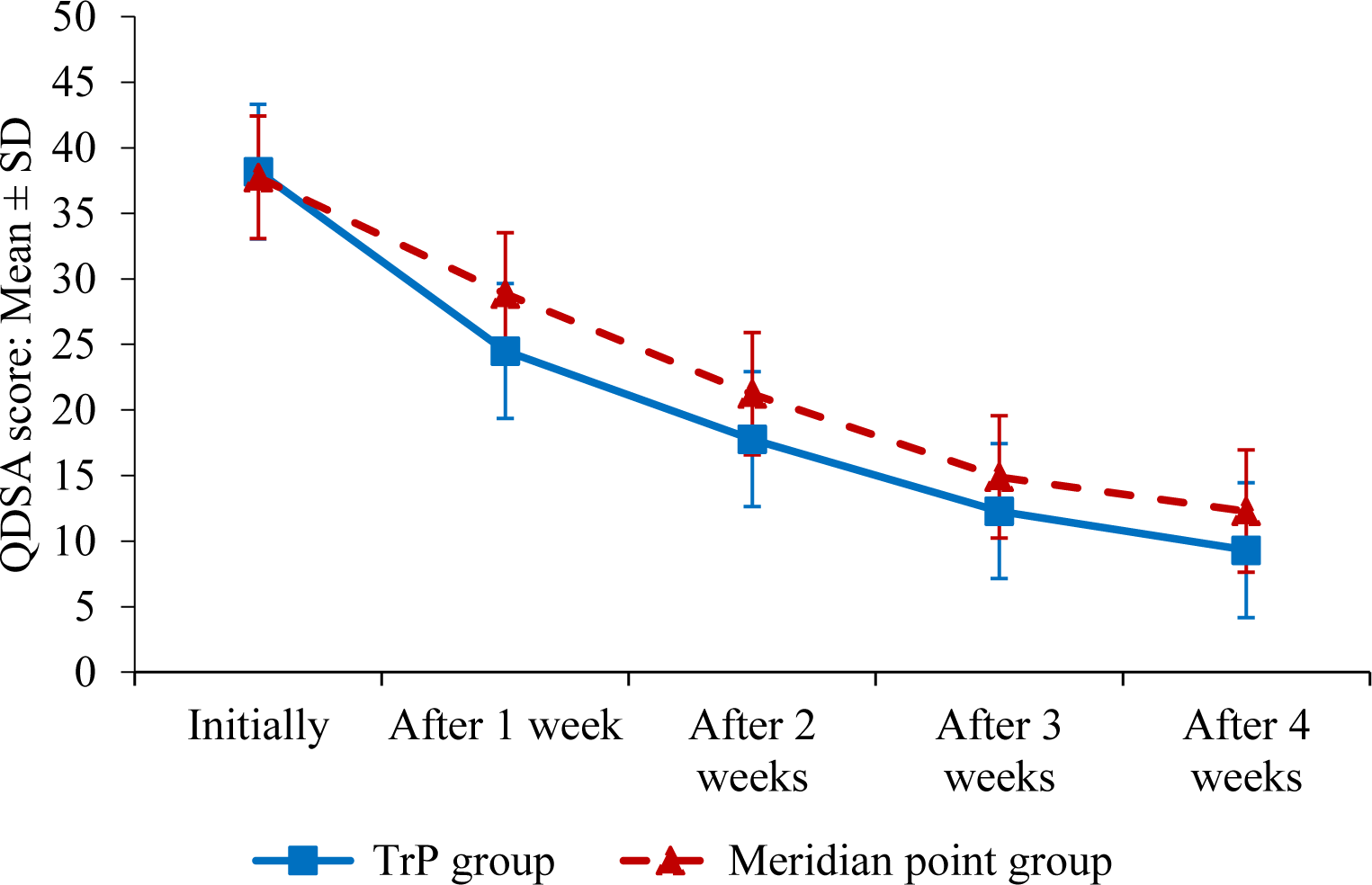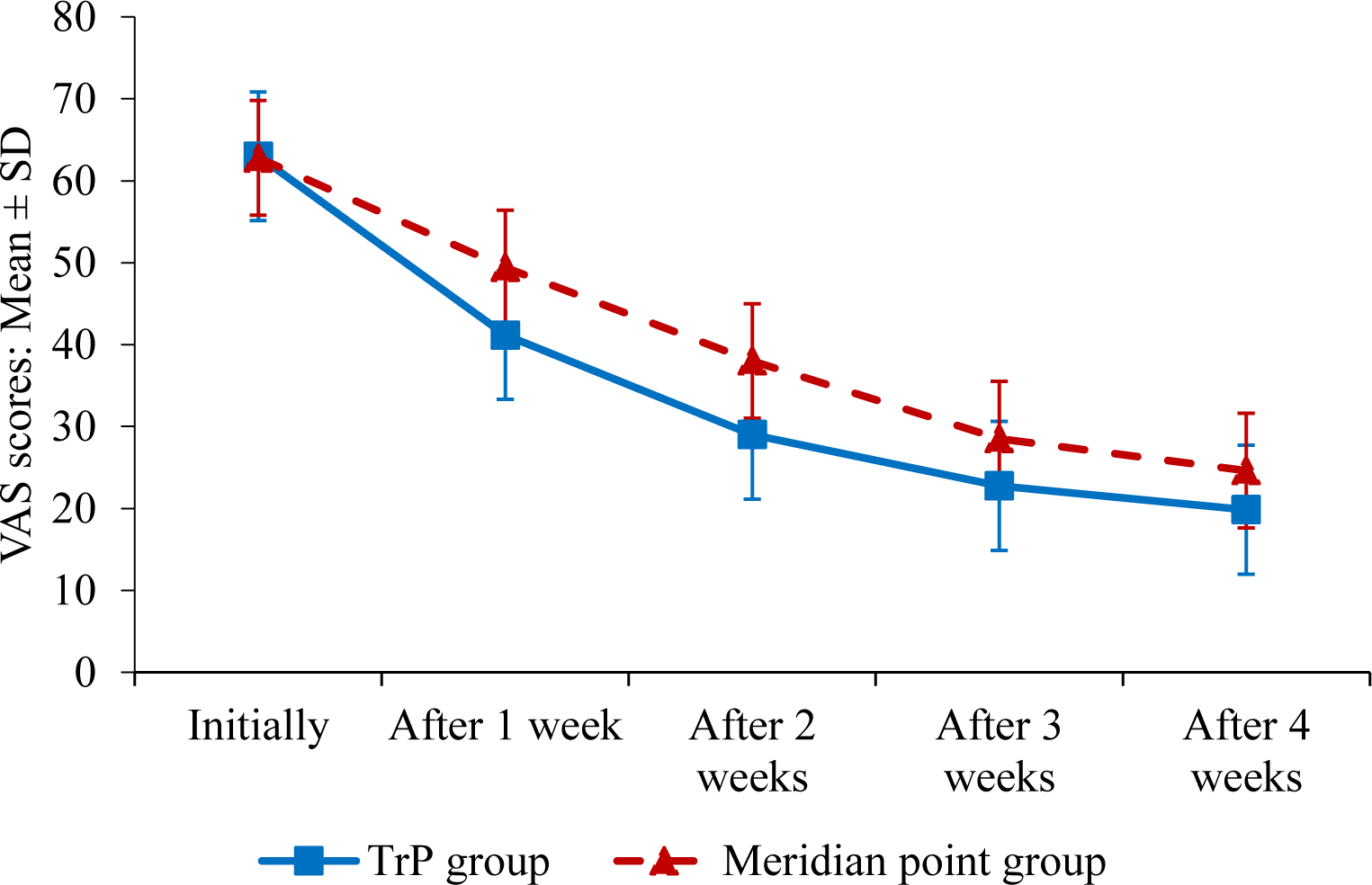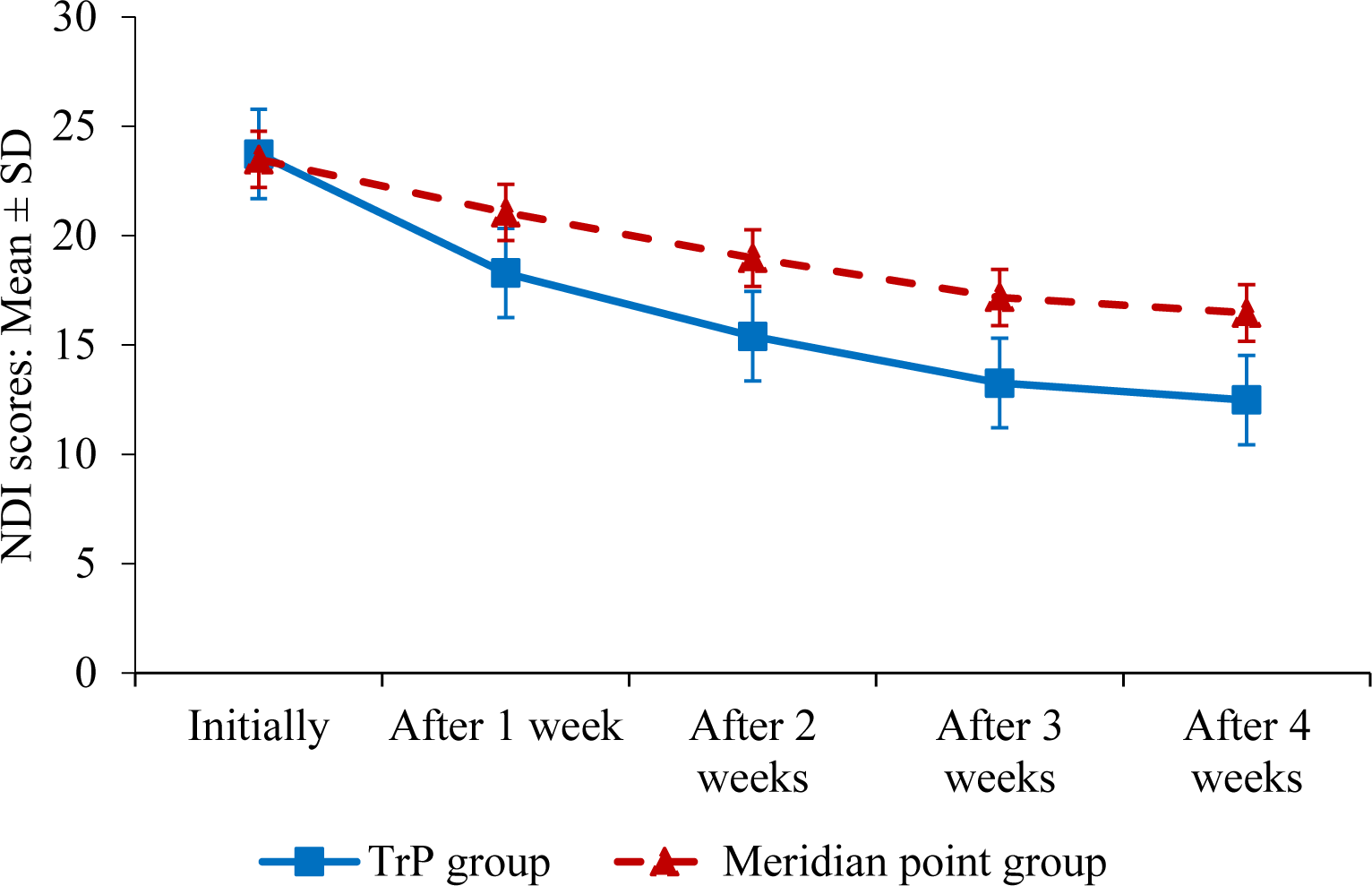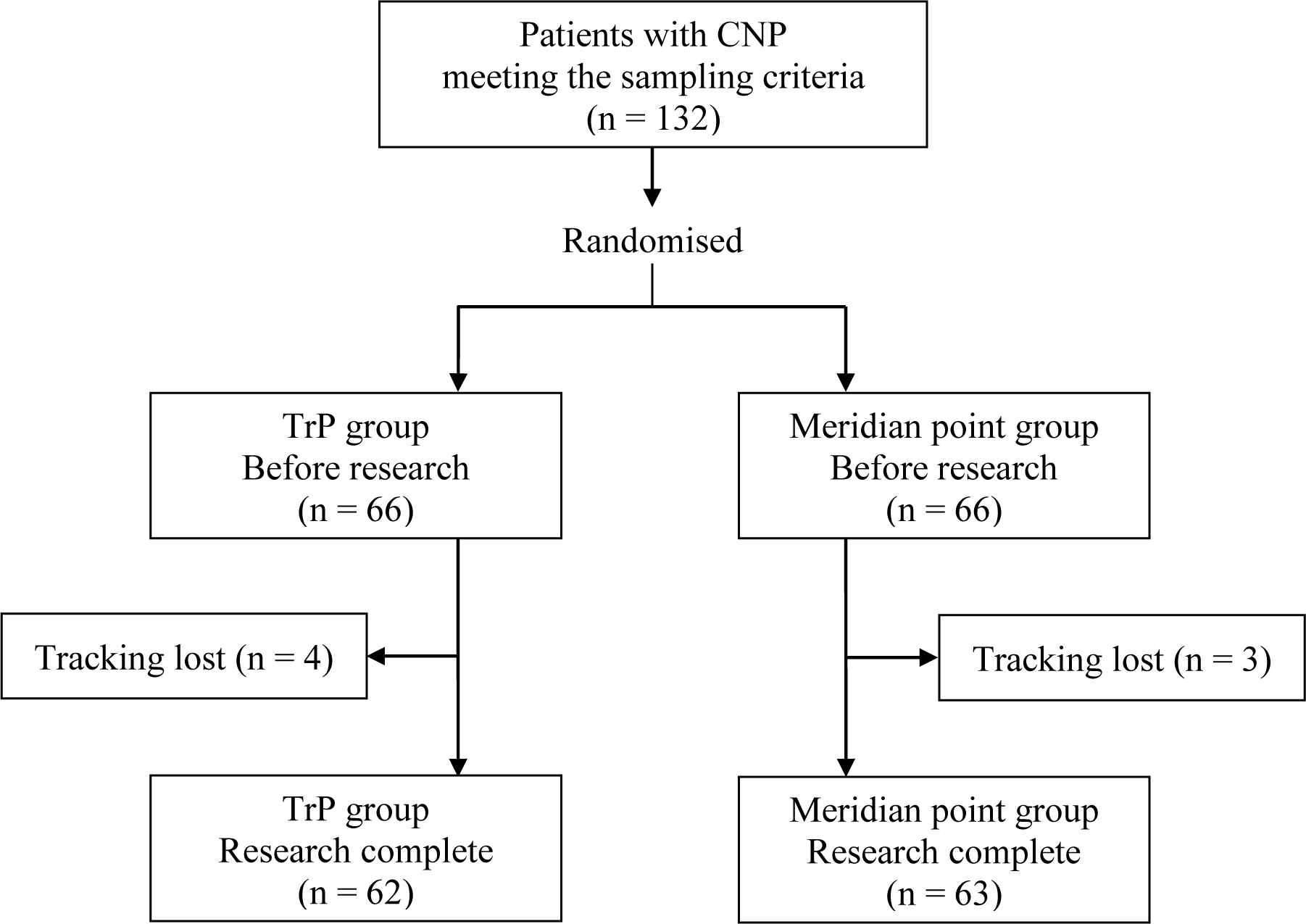1. INTRODUCTION
Neck pain is one of the leading causes of disabilities and increasing economic and social burden [1]. Statistics indicate that neck pain makes up 30 - 50% of the general population [2], 30% of which will escalate into chronic neck pain (CNP) [3] lasts for more three months [4]. Similarly, in Vietnam, at Traditional Medicine Hospital in Ho Chi Minh City, neck pain is among the popular worries, making up 26.8% of the total number of patients getting examinations and treatment [5].
CNP treatment methods of modern medicine currently in use include pain relief medicines, muscle relaxants, non- steroidal anti-inflammatory drugs (NSAID), physical treatment, function restoration, and spinal cord injection… [6]. Among these, groups of pain relief and NSAIDs are the most commonly used groups of medicine; prolonged use of these medicines increases the risk of side effects on the heart, digestive system, kidney… and affects patients’ treatment tolerance [7].
Traditional medicine also treats CNP with different methods. One of those methods is Electroacupuncture (EA) - a method without the use of medicines and with safety as an advantage; it was proven through many researches to be an effective pain reliever, playing a part in improving patients’ life quality [6]. Besides, in recent years, treatment methods affecting sores in muscles (Trigger point - TrP), share certain similarities with the Ashi point of Traditional Medicine but have specific spots (in muscle). These methods are encouraging more research to be conducted [8]. The author Itoh and his partners conducted initial research [9] on 40 CNP patients classified into 4 groups; the results indicate that acupuncture at TrP not only brings about better pain relief effectiveness than acupuncture at meridian points but also reduces the number of intervened points, which helps decrease the degree of invasion for patients. Contributing to research in this field. In Vietnam, there are no studies on evaluating the pain relief effectiveness of EA at TrP compared with EA at meridian points in patients with CNP. In Vietnam, the study was carried out on patients with CNP at a Traditional Medicine Hospital with a larger sample size than Itoh’s study to compare the pain relief effect of the EA at TrP group compared with EA at meridian points group.
2. MATERIALS AND METHOD
This study was conducted at the Examination Department, Traditional Medicine Hospital in Ho Chi Minh City from September 2020 to June 2021.
Study design: This is a non-blind randomized controlled trial study. A total of patients will be randomly assigned in a 1:1 ratio.
Participants criteria included: (1) over 18 years of age; (2) neck pain for more than 3 months or with multiple relapses; (3) Questionnaire Douleur Saint-Antoine (QDSA) score > 32; (4) limited amplitude of physical movement of the spinal column; (5) agreed to participate in the study.
Participant’s elimination criteria: (1) neck trauma, myocardial ischemia, arterial dissection; (2) systematic diseases such as rheumatoid arthritis, ankylosing spondylitis, psoriatic arthritis, Down syndrome, spina bifida, Scheuermann disease; (3) central motor neuron lesion such as Hoffmann sign, Babinski sign, hyperreflexia, spasticity, incontinence, sexual dysfunction; (4) under treatment with pain-relieving medicines in use within the past month, such as opioids, NSAIDs, corticoid, Gabapentin, Pregabalin, Tricyclic Antidepressant (TCA), under treatment with massage or acupressure, physical therapy; (5) using alcohol, drug; (6) states unsuitable for acupuncture such as inflammation at the areas of skin that need acupuncture, systemic diseases, infection [10].
Sample size is measured based on a formula comparing two percentage:
With α = 0.05 and β = 0.2; the percentage of patients reaching good pain-relieving effectiveness in EA at the meridian points group is p1 = 0.48 [11]. The percentage of patients reaching good pain-relieving effectiveness in EA at TrP is p2 = 0.73. From these data, the drawn minimum sample size for each group is 59 patients. The expected loss of sample rate is 10%; thus, it is necessary to select 132 patients to participate in the research.
Patients suffering from CNP meeting the disease selection criteria will be randomly put into EA at TrP or EA at meridian points group.
Random method: Patients agreeing to participate in the research will proceed to take part in a lucky draw with the draw number ranging from 1 to 132. Patients drawing odd numbers will join EA at the TrP group; those with even numbers will join EA at the meridian points group.
EA at TrP group: The important muscles which tend to have TrP when suffering from CNP are splenius capitis muscle, trapezius muscle, sternocleidomastoid muscle, scalene muscle, levator scapulae muscle, sacrospinalis muscle, and suboccipital muscle [9, 12]. TrP can be determined by gently palpating the surface or by pincer palpation along the stretched muscles; feelings of small spots and intense pain when pressed are the indications of TrP, researchers hold the TrP in place with the thumb and index finger of the left hand [13], mark the TrP(s) with Viscot pen and intervene on top of the TrP during the whole research. Using disposable acupuncture needles (0.3 mm x 40 mm, Arlo, China), quickly insert the needle using the right hand so that it is perpendicular to the skin and deep into the TrP, the depth depends on how thick the patients’ muscles are, stimulating the needle until “De qi” sensation is attained. Continue this with all the other determined TrP. After every week of treatment, researchers will re-evaluate the number of TrPs and cease needling where TrP no longer exists.
EA at meridian points group: Patients are needled at Feng Chi (GB 20), Jian Jing (GB 21), Jian Gu (LI 15), He Gu (LI 4), Jian Wai Shu (SI 14), Da Zhui (GV 14), Huatuo-Jiaji points C1-C7 (EX B2) (depending on the painful spinal column section) [11]. Disposable acupuncture needles (0.3 mm x 25 mm, Arlo, China) are used. The thumb and index finger of the left hand are used to press the skin where the point lies; quickly needle through the skin where the point lies; push the needle slowly along the acupuncture point, and stimulate the needle until “De qi” sensation is attained.
Both groups involve the stimulation of EA machines (Senseplus, CWM-202, ChungWoo, Korea), mode 4, frequency 100 Hz, needle staying time 20 minutes. The EA treatment process is 1 time/day x 5 times/week and lasts continuously for 4 weeks.
Both groups are instructed to do active exercises for the cervical spine at home, including exercises for neck movement amplitude, stretching cervical muscles, heavy exercises for cervical muscles, and shoulder belt relaxation [14].
EA is carried out by acupuncture experts with at least 5 years of clinical experience.
Evaluation and data collection: All the questionnaires are completed by the participants with the necessary instructions from the researchers.
Questionnaire Douleur Saint-Antoine (QDSA) was the primary outcome, consisting of 58 words and 16 classes, in which classes 1 to 9 assess the patient’s pain sensation and classes 10 to 16 assess the effect of pain on mental status [15].
Visual Analog Scale (VAS) is a unidimensional measure of pain intensity, expressed as a horizontal or vertical line segment of 100 mm in length. The two ends of the line are described in words, corresponding to the two extremes of pain: the left end (0 mm) of the scale is “no pain” and the right end of the scale (100 mm) is “worst imaginable pain” [16].
Neck Disability Index (NDI) The NDI consists of 10 patient-assessed items, related to daily activities, including pain intensity, personal care, lifting, sleep, driving, recreation, headaches, concentration, reading, and work [17].
The number of Triger points: Count the number of Triger points per patient in each study group. Identifying TrP is based on international consensus on diagnostic criteria and clinical considerations of myofascial trigger points [18].
Complying with active cervical spine exercise: Assess the number of times patients comply with active cervical spine exercise during the study period.
Outcomes were assessed at baseline, after 1 week, 2 weeks, 3 weeks, and 4 weeks of treatment.
Adverse events: Evaluate the adverse events during the study period including pain, swellings, bleeding, infection at the needle positions; Nausea, dizziness, low blood pressure.
Analyzing statistics using Stata 14.0
Qualitative variables: age, gender, pretreatment, diagnosis, adverse events are described with percentage. The percentages are compared using Chi-square tests (χ2); if the number of blanks having an expected frequency smaller than 5 makes up 20% of table 2 x n then Fisher’s exact test will be used as an alternative.
Quantitative variables: QDSA, VAS, NDI, the number of TrPs, active cervical spine exercises are described with mean and standard deviation, using t-test for comparison.
3. RESULTS
132 patients meeting the sampling criteria and agreeing to participate in the research are randomly divided into groups: the TrP group (n = 66) and the meridian point group (n = 66). During the research, 4 patients in the TrP group and 3 patients in the meridian point group stopped participating; due to the impact of COVID-19, they cannot get re-examined on schedule. Analyzing the research results based on the statistics from 62 patients of the TrP group and 63 patients of the meridian point group (Figure 1).
Most patients participating in the research are within the age range of 40 - 59 and females make up the majority. More than 45% of patients were treated with NSAIDs beforehand, physical treatment and acupuncture were also applied. On the whole, the differences between the initial characteristics of the two groups are not statistically significant (p > 0.05) (Table 1).
According to Table 2, Figure 2, Figure 3, and Figure 4, after every week of treatment, both TrP and meridian point groups have statistically significantly lower average QDSA, VAS, and NDI scores compared with the initial state (p < 0.01). However, the decreasing rates of QDSA, VAS, and NDI of the TrP group are statistically significantly higher than the meridian point group at every evaluation time.



According to Table 3, the percentage of patients reaching good pain-relieving effectiveness measured by QDSA of the TrP group (71.0%) is statistically significantly higher than the meridian point group (47.6%) (p < 0.05). Besides, in the TrP group, no patient responded with poor pain-relieving effectiveness compared with the 6.4% of the meridian point group.
| Classification | TrP group | Meridian point group | p | ||
|---|---|---|---|---|---|
| n | % | n | % | ||
| > 75% (Good) | 44 | 71.0 | 30 | 47.6 | 0.021* |
| 50 - 75% (Decent) | 14 | 22.6 | 23 | 36.5 | |
| 25 - 49% (Average) | 4 | 6.4 | 6 | 9.5 | |
| < 25% (Poor) | 0 | 0 | 4 | 6.4 | |
Both study groups were evaluated for the number of TrPs at baseline and after each week of treatment. Table 4 shows that the number of TrPs in the TrP group was less than in the acupuncture group after each week, a statistically significant difference (p < 0.05).
According to Table 5, the differences between the average times doing active cervical spine exercises of the TrP group and the meridian point group are of no statistically significant when comparing from week 1 to week 4 and the mean of all 4 weeks of research (p > 0.05)
Within 4 weeks of treatment, pain at needle positions is the only adverse event to happen in both groups.
According to Table 6, the differences between pain at needle position events of the TrP group are not statistically significant compared with the meridian point group (p > 0.05).
| Adverse events | TrP group | Meridian point group | p | ||
|---|---|---|---|---|---|
| n | % | n | % | ||
| Pain at needle positions | 16 | 25.8 | 8 | 12.7 | 0.063* |
| None | 46 | 74.2 | 55 | 87.3 | |
4. DISCUSSION
Evaluated by QDSA, after 1 week of treatment, the QDSA score of the TrP group decreases compared with the initial state, the decrease is higher than that of the meridian point group, and this difference is statistically significant (- 13.69 ± 3.32 in comparison with 8.89 ± 2.27; p < 0.01). This result indicates that both the TrP and meridian point group showed a fast and high rate of pain-relieving effectiveness after 1 week of treatment. After 2, 3 and 4 weeks of treatment, the average QDSA scores of the TrP group all have lower scores than the meridian point group. As a result, we propose that EA at TrP brings about faster as well as more pain-relieving effectiveness than EA at meridian points. Compared with other research making use of QDSA in evaluating cervical spine pain-relieving treatment, we recorded the QDSA score decreasing rate of TrP the group in our research to decline 75.6% compared with the initial state. This is higher than 68.1% of Nguyen TKN’s research (2012) [11] and 57.4 % of Vo TMP’s research (2017) [19]. Unlike VAS which only measures a 1-dimensional degree of pain, QDSA describes many different kinds of pain, which helps evaluate various types of pain including pain due to the receptor and neuropathic type pain [16]. Previous research proved that CNP, despite no nerve root compression, still consists of nerve pain elements and an increase in sensitivity to pain at the neck [20]. Besides, chronic pain also affects patients’ emotions and is closely connected to anxiety disorder and depression [10]. Therefore, faster and better improvement in QDSA score will reduce the disease-related and mental burden on patients.
The percentage of patients to reach good pain-relieving effectiveness measured by QDSA of the TrP group (71.0%) is statistically significantly higher than the meridian point group (47.6%), (p < 0.05). No patient responded with poor pain- relieving effectiveness in the TrP group according to QDSA; while the meridian point group has 6.4%. Therefore, from our observation, EA at TrP increases the percentage of responding patients and reduces the percentage of patients failing treatment compared with EA at meridian points. Comparing with researches evaluating neck pain-relieving effectiveness measured by QDSA conducted by domestic authors, we observed that the resulting responding rate of good pain- relieving effectiveness of TrP in our research is 71.0%, much higher than 48.0% of Nguyen TKN’s research (2012) [11] and 21.1% of Luong TKD’s research (2020) [21]. This could be an intervening solution to be applied to CNP patients who failed EA at meridian points.
Measurement with VAS showed that, in the TrP group, the VAS score declining rate after 1 week of treatment is statistically significantly higher than that of the meridian point group (- 21.84 ± 2.69 in comparison with - 13.33 ± 3.10; p < 0.01). For neck pain patients, the minimum change in VAS score needed to attain statistical significance is 13 mm, and any change above 21 mm is considered to be of clinical significance [22]. After 1 week of treatment, VAS score declining rates of both groups in our research are 13 mm, proving that both groups have early pain relief which is of significance; however, only the TrP group reached the improvement rate of clinical significance (- 21.84 ± 2.69), meridian point group only stopped at the statistical significance rate (- 13.33 ± 3.10). Only after 2 weeks of treatment did the meridian point group reach the improvement rate of clinical significance (- 24.76 ± 6.04). Thus, we propose that both EA at TrP and EA at meridian points have pain- relieving effectiveness of clinical significance according to VAS, and EA at TrP showed more speed and efficiency than EA at meridian points.
Measurement with NDI indicated that the NDI score declining rate of both TrP and meridian point groups are at the highest after 1 week of treatment and decrease gradually in the following weeks until treatment is complete. However, the declining rate of the TrP group is statistically significantly higher than the meridian point group at every evaluation time (p < 0.01). According to a synthetic analysis, research using NDI during neck pain relief treatment evaluation has 7 as the minimum changing score of clinical significance [23]. TrP group’s changing score is - 5.44 ± 1.41 after 1 week of treatment and - 8.32 ± 2.13 after 2 weeks of treatment. The meridian point group, on the other hand, only declines - 2.43 ± 1.48 after 1 week of treatment and reaches a declining rate of - 7.02 ± 4.20 at the end of the research (after 4 weeks). Therefore, it is suggested EA at TrP indicated statistically significant faster and better clinical efficiency than EA at meridian points.
After 1 week of treatment, both groups have a statistically significant decrease in the number of TrPs compared with the initial state. However, the number of TrPs in the TrP group decreases more than that of the meridian point group (5.2 ± 1.9 in comparison with 6.0 ± 2.1; p = 0.030) and the number of TrPs in the TrP group at the end of the research still remains statistically significant lower than meridian point group (1.7 ± 1.4 in comparison with 3.0 ± 2.1; p = 0.001). The decreasing rates of the number of TrPs of both groups decline over time, this totally corresponds with pain relief degree measured by QDSA, VAS and NDI. As for the TrP group, we will reduce the number of needles in accordance with the decrease in the number of TrPs after every week of assessment; however, for the meridian point group, the EA point formula remains in place for the whole research. In conclusion, along with the effect of reducing the number of TrPs, EA at TrP also has the advantage of reducing the intervening needles, which helps decrease the degree of invasion on patients after every week of treatment.
Cervical spine exercises are recommended in many European clinical practice guidelines on managing neck pain with average quality of evidence [24]. In this research, we use cervical spine exercises as a common intervention measure for all patients in the two groups to ensure all of them receive optimal treatment as advised. Evaluating the number of times doing active cervical spine exercise during the 4 weeks of the research and the mean of all 4 weeks indicate no statistically significant difference between the two groups (p > 0.05), this shows that most patients in the research complied with guided training; because both groups share the same degree of compliance, elements which might make the pain relief effect biased are omissible. Thus, both methods entail improved movement.
Within 4 weeks of treatment, pain at needle positions is the only adverse event of both research groups. It is a minor symptom and subsides within 48 - 72 hours. Although the likelihood of adverse events in the TrP group is higher than that of the other group, the difference is not statistically significant (p > 0.05). A synthetic analysis evaluating the effectiveness of acupuncture at TrP in neck pain treatment indicated that the probability of minor adverse events made up 53.6% (15/28 of the research) and no severe adverse event was reported. Post-needling soreness at TrP is the most common adverse event, making up 53.3% (8/15) of the research and patients recover from this within 24 - 48 hours without any treatment [25]. Thus, it is suggested EA at TrP has a high degree of safety.
In this research, post-treatment observation hasn’t been conducted. Thus, it is not yet possible to evaluate the sustainability degree of pain-relieving effectiveness of intervening measures. At the same time, it is not yet evaluated whether the post-intervention relapse rates of the two groups are statistically significantly different or not. Therefore, in the following researches, it is suggested there should be post- treatment observation from 3 to 6 months to evaluate the effectiveness in reducing the relapse rate.
The overlap rate of TrP positions with the acupuncture points on each patient is not yet measured and statistically analyzed. As TrP positions can accidentally overlap with positions at meridian points, if the number of overlaps is significant then the effectiveness of EA at TrP and EA at meridian points could be erroneous. Thus, it is suggested that following researches statistically analyze variables on the overlaps of TrP positions and acupuncture point positions to eliminate any miscalculation.









